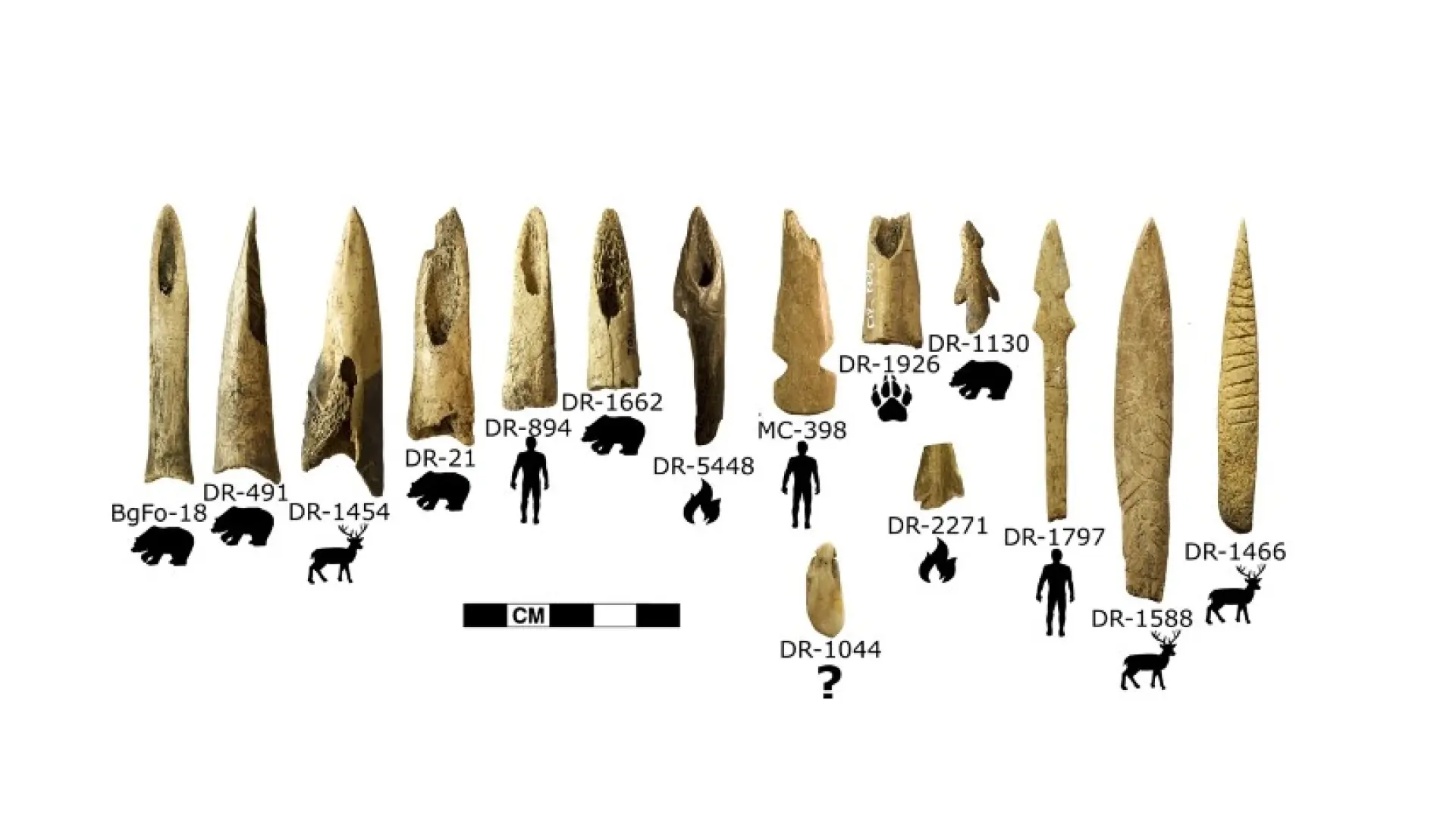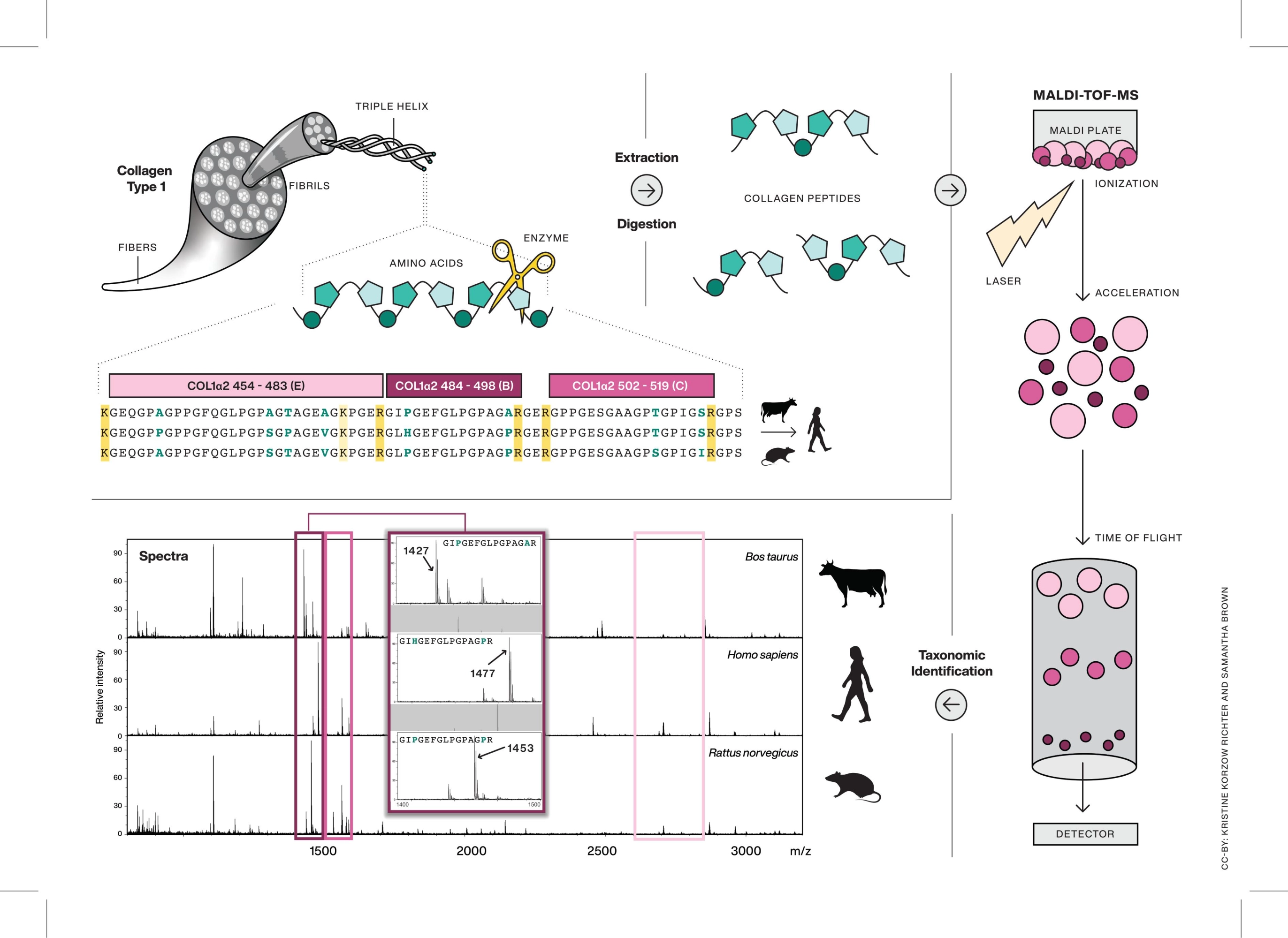Collagen ‘fingerprint’ that can extract information from small fossil bones

For more than a decade, archaeologists and paleontologists have had a new tool to study the past and learn from it. It has a rather long name: zooarchaeology using mass spectrometry, but is commonly known by the acronym ZooMS.
Although large numbers of bones have been found in many archaeological sites, most of them are very fragmented and have no characteristic features that would allow one to determine which animal they belong to. using traditional methods of morphological identification.
It has been calculated, for example, that only a third of the bones found in Pleistocene sites can be identified by visual inspection. Bone fragments are also found in museums.: They are the poor relations of your collections, pushed into the background awaiting a new opportunity.
Nowadays, thanks to relatively new ZooMS methodology Researchers can extract information from these samples that may at first seem insignificant. What is the basis for this method?
molecular barcode
While most proteins degrade quickly after an animal’s death, some persist for long periods of time. This is the case with collagen I, the main organic component of bones, teeth, antlers and skin. ZooMS, developed in 2009 by Matthew Collins and his then student Michael Buckley at the University of York. uses differences in collagen from different animal species as a molecular barcode determine which of them corresponds to the hitherto unclassified bone fragment.
If we compare collagen from different groups of animals, we will see that in many positions of the protein sequence they have the same amino acids, while in other positions the amino acids are different. The greater the evolutionary distance between animals, the more differences are present in their collagen.
To analyze collagen using ZooMS, it must first be extracted from the sample. The protein is then fragmented into small peptides using the enzyme trypsin (the same one produced by our pancreas that helps us digest proteins in the small intestine), and the samples are placed on metal plates to be analyzed using a spectrometer, a device used to measure the masses of the various peptides present in the sample.

Small differences in collagen sequence, even between closely related groups of animals, result in the formation of peptides with different masses, creating “fingerprint” for each animal. Finally, the resulting patterns (spectra) are compared with reference library samples to determine with a high degree of accuracy what type of animal they correspond to.
Is this a human bone?
ZooMS resolution allows the sex of the animal to be determined; that is, if a bone fragment corresponds to, for example, a goat (genus Capra) or a sheep (genus Ovis), then both are bovine. However, the species as a whole is not deciphered. Despite this, This is a very valuable tool for determining whether any faunal skeletal remains located at a site are consistent with a human ancestor.
On the other hand, with ZooMS Distinguishing between species that are very closely related evolutionarily is quite a difficult task.is impossible if other archaeological or paleoanthropological context data are not available. Hominids such as gorillas, orangutans, Neanderthals (Neanderthal man) or ourselves (Homo sapiens) we have collagen sequences that are indistinguishable from each other in the spectrometer. In these cases, if DNA could be extracted from the fossil, it could be sequenced and serve to confirm the species to which it corresponds; but DNA is not as well preserved as collagen and cannot always be analyzed.
Among the remains of fauna found at sites and not recognizable due to their altered appearance, there are also human-made artifacts such as bone or horn tools, leather goods, and scrolls.In these cases, ZooMS is also useful for determining which animals they correspond to.
Nature non-destructive This technique makes it an excellent tool for preserving and studying these valuable artefacts. It has been applied, for example, to museum collections, allowing researchers to identify and catalogue specimens without causing damage, and in the last decade, increasingly less invasive methods have been developed to extract collagen from specimens.
Another achievement made in recent years is the construction increasingly complete databases. This expands the range of animals that can be identified by this method. Initially, these libraries were created using collagen sequences from mammals only, but now also include bird and fish species.
Hidden Treasures in Museums
Recently, researchers from Germany and the United States explored the potential of ZooMS to identify fossil bone fragments from the collections of the National Museum of Natural History in the United States. The scientists analyzed the museum’s late Pleistocene megafauna samples from six Colorado sites. In 80% of cases, they were able to identify the group of animals to which the fragments belonged.
Using the data obtained, You will be able to study what the ecosystems of the past were like and what animals coexisted in them.The authors of the study emphasize that ZooMS may be of great importance in answering one of the important questions of paleontology. 50,000 years ago, the American continent was dominated by megafauna such as mammoths, mastodons, saber-toothed tigers and huge wolves, as well as bison, unusually tall camels, giant beavers and huge sloths weighing more than a ton. After the last ice age (the so-called Ice Age), most of these large mammals disappeared. What caused the extinction of large mammals in America?
There are two main hypotheses: some researchers believe that the arrival of humans on the continent was the main reason, while others argue that climate change (characterized by rising temperatures, melting ice, and changes in ecosystems to which megafauna could not adapt at the time) was the determining factor. The question remains unresolved, but a new study suggests that It may well be possible to apply ZooMS to remains from this period stored in various museums to help solve the mystery.
Find a needle in a haystack
This method has also been applied to the study of human evolution. Using fragmentary bone remains from this site, it is possible to study the behavior of the groups of people who lived there and their interactions with the environment. For example, with ZooMS you can study what animals were in their diet and what hunting strategies archaic humans had. In the case of Neanderthals, this method confirms that they ate large herbivores such as reindeer, horses, and bison, or that they selectively used the ribs of large cattle such as bison and bison (rather than reindeer ribs) to make tools.
One of the best examples of the potential of this method for studying human evolution is found in the Middle and Upper Pleistocene site of Denisova Cave in the Altai Massif in Siberia. The cave became famous more than a decade ago because it New Type of Archaic Human Related to Neanderthals and Sapiens Discovered who were called Denisovans.
The paleontological remains of this site (95% of them) are very fragmented.probably due to the action of scavenging animals. In fact, to date, no complete or partial skull of a Denisovan has been found, and its original description was based on the study of ancient DNA extracted from small bones found in a cave.
Years after its identification and thanks to the development of ZooMS, Analysis of Denisova’s bone fragments made it possible to identify new hominid remains. The idea to apply this method to the remains of a Siberian cave was owed to two researchers, a couple named Katerina Duca and Tom Higham, then at Oxford University. The crazy idea was like looking for a needle in a haystack: painstaking work, involving the analysis of thousands of bone fragments, most of them from other animals present in the same cave deposits, until a fragment of archaic human bone was found. And yet it paid off.
Isolated bone fragments may still contain DNA that provides important information about the cave’s past inhabitants. Nine new hominin remains have been identified using this method, including two Neanderthals and three Denisovans. And most astonishingly, DNA was extracted from the first 2cm bone fragment found using ZooMS, dubbed Denisova 11 or “Deni,” and analysis of its genome showed that it belonged to a female Neanderthal. mother and a Denisovan father. A unique specimen in the world! The latter actually found a needle in a haystack.
